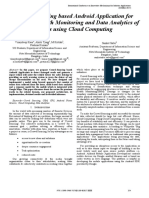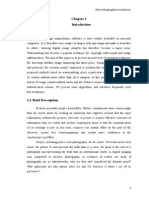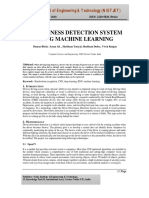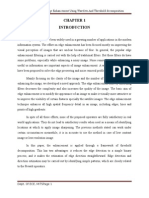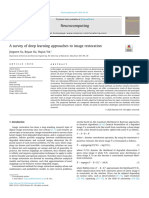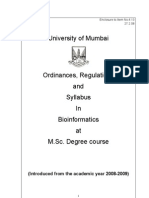Image-Based Vehicle Detection Using Various Features
Image-Based Vehicle Detection Using Various Features
Volume 7, Issue 1, January – 2022 International Journal of Innovative Science and Research Technology
ISSN No:-2456-2165
Image-Based Vehicle Detection using Various
Features
Saikat Goswami, Mohammad Shorif Uddin Mahia Rezwana Oishi, Shaiedul Islam Shehab,
Department of Computer Science & Engineering Nazmus Shakib
Jahangirnagar University Department of Computer Science & Engineering
Dhaka, American International University-Bangladesh
Bangladesh Dhaka, Bangladesh
Abstract:- There are frequent vehicle accidents in our required application to application by accuracy and
country due to reckless driving and also break the driving nature.[33] Here application depends on subset 2D pose
rules. So, main purpose for this research comes from the parameters and fines the result of damage to the vehicle. In
situation of our country worsts vehicles. Now-a-days in the research paper overall objective is to be able to
our country vehicles damage are increasing rapidly. This automatically detect mild damage in vehicles using
is why a concept that emphasizes on the betterment of our photographs. And these photographs taken by the camera or
country traffic environment. Here, apply two methods for mobile phone.[11][19].
detect the vehicle. Such as Lens-based vehicle Classifier
and Haar cascade classifier. Lens-based Vehicle Classifier II. DETECTION CONCEPT AND METHOD
and Haar cascade classifier used for utilize the object
detect of the vehicle. And all the procedure is held with A. LVC Method
camera and sensor to detect the vehicles. In the primary In this method, at first take some photographs of the
level, DSLR camera takes multiple photographs in a vehicle (car, bus and bike) by DSLR camera. DSLR cameras
different way after the image is resister in database. All capture the photographs by three types of lens like Kit lens,
the process is held like heat map, bounding box, threshold zoom lens and Prime lens. Kit lens (18-55mm) measures the
and merged box in database. So, heat map highlights the group photographs of vehicle, zoom lens measures the certain
image and send to the bounding box for predict. This distance (70-300mm) photographs of vehicle and prime lens
prediction is also a smaller number of images. Heat map measures the close distance (40mm) photographs of vehicles.
are used for bounding box that threshold of 85% Lens-based Vehicle Classifier (LVC) is a method utilized for
probability of any class of object. Regressor when detecting the vehicle object. This method has 2 points for
included the output of image pixel are merged. And detecting the vehicle object, such as Strong Classifier and
finally, all the procedure done and get a result of vehicle Estimation of Related distance. Strong Classifier is a
detection that accuracy 85% or less. rectangular feature providing specific indication to an image.
Estimation of Related Distance measures 2 categories like
Keywords:- Computer Vision & Digital Image Prrocessing. Image Cropping [Vertical] and Image Cropping [Horizontal].
In obtaining vehicle object detection value, Strong Classifier
I. INTRODUCTION was calculated using integral image. Integral images could
calculate values accurately and relatively quickly by creating
It is a challenging task to detect vehicle damage a new presentation of the image by using the value of the
automatically when an accident occurred. After an accident, region previously scanned by a specific strong classifier. The
it’s very difficult to use photographs taken at the accident value of the integral image was obtained by the sum value of
scene. This fascinating repertoire of computer vision the previous index, started by left top until right bottom.
problems solving is also a challenging task.[7] Vehicle has a
very metallic body and photographs taken to the uncontrolled
area or environment, is also challenging applying computer
vision techniques. Here, using different methods such as
image segment is one of the major problems in computer
vision. Image segment techniques photograph pixel defends
on different color and texture. Therefore, it’s a challenging
task for this object to segment sub parts and boundary cues
(both parts of the vehicle).[18][20] The original parts and
projected parts of the 2D model are not matched in the
photograph damage vehicle. Image segment method using for
contour initial information for this 2D pose of projecting
parts model. Hence, we mainly focused on the vehicle's
image and also reflected the surface of the vehicle
body.[9][15] Now, another problem is estimation in computer
vision that application is used in vision image analysis.
Generally, the process of estimation of obtained an object Fig.1 - LVC Method
part of location to its surroundings. Here, our work is also
restricted for non-articulated objects. 2D pose estimation
IJISRT22JAN755 www.ijisrt.com 709
Volume 7, Issue 1, January – 2022 International Journal of Innovative Science and Research Technology
ISSN No:-2456-2165
B. Haar Cascade Classifier probability at least 85% or less. Then image go for the
Haar Cascade Classifier is a method utilized for detecting merged box section. Merged box means all the images are
objects. This method has 4 points for detecting an object, merged and sent to the classifier section. In the classifier
such as a Haar-like feature, integral image, AdaBoost section apply Multiple Haar-like classifiers for V-J scheme-
learning and Cascade Classifier. Haar-like feature is a based approach.[4][5] And finally the image gone regressor
rectangular feature providing specific indication to an image section that means encoded the image range and gives the
Haar-like feature offers high speed computation depending output in the display screen.
on the number of pixels inside the rectangle feature and not
depending on each pixel value of the image. In obtaining At first take the image from the camera then register to the
object detection value, Haar- like feature value was database. And this image passing is recorded from the
calculated using integral image. Integral images could database to framework. Aerial image of moving objects can
calculate values accurately and relatively quickly by creating be categorized by frame based and segmentation based.
a new presentation of the image by using values of regions Image segmentation represents the complete shape of the
previously scanned by specific Haar-like features. The value objects. It means pixels with similar colors and attributes
of integral image was obtained by the sum value of the are together in image segmentation. In-put images are
previous index, started by left top until right bottom. annotated pixel wise where captured by the camera of the
vehicle. Image goes to bounding boxes where coordinates
the pixel. Bounding boxes is a one to one correspondence
class prediction. This prediction is also a smaller number of
images.[27][30]
Heat map is the output from the image of each pixel that
coordinates to the bounding box. Heat map is representing
the color as a matrix. Fractal and tree both maps are used in
heat maps. When inputting an image to the system then
heat map observed the image then sent to the bounding box
where the image pixel is optimized to the map. Heat maps
are used for bounding boxes that have a threshold of 85%
probability of any class of object.[8][1][20]
In the simplest implementation, the output is a binary
Fig. 2: Haar Cascade Classifier image representing the segmentation. Black pixels
A. Framework correspond to background and white pixels correspond to
foreground. In simple implementations, the segmentation is
determined by a single parameter known as the intensity
threshold.[34]
When threshold is used in the bounding box then goes to
the merged box. This approaches all the bounding boxes for
their classifications of objects.[21][16]
Multiple Haar-like classifiers are used in the V-J scheme-
based approach. It’s a strong classifier. This feature is
drawn essentially for Haar basis functions for the image.
Specific location for window detection at a different
rectangular region. This region is rapidly used for the
image called integral image.[12][23]
The range regressors are trained after the training of
classifier and bounding box regressor. Range regressors are
encoded with the distance of meter objects. Range
regressors when included the output of the image pixel are
merged.[25]
III. EXPERIMENTAL RESULT AND ANALYSIS
Fig. 3: Flowchart of the Inference Process to Detect The original goal was to detect mild vehicle damage
the Vehicle using photographs that propose to use images obtained from
the photograph and filter the edge to detect mildly damaged
C. Overview regions in the vehicles. Image edge result from vehicle
Fig. 3, discuss the framework of vehicle detection and undamaged part in addition to damage region. 2D projection-
how it works. First take the image from the DSLR camera as based model used to identify the vehicle undamaged part of
an image input that registers to the database. Then image the image edge.[13][32].
output goes for the heat map that image pixels coordinate as a
bounding box.[26] Then goes for the thresholding section. However, the vehicle body is very reflective and there is
Thresholding observed the output image of the heat map. a large amount of inter object reflection in the photograph
Then predict the detect object of the vehicle and it’s
IJISRT22JAN755 www.ijisrt.com 710
Volume 7, Issue 1, January – 2022 International Journal of Innovative Science and Research Technology
ISSN No:-2456-2165
which is interpreted to damage. So, proposed a method for
classifying reflection in photographs.
In this chapter, there is some limitation work to detect
the reflection image edge in close photographs in vehicle
panels. At last, it's possible to implement vehicle damage.[9]
A. Experimental Evaluation
Here, apply HAAR CASCADE features to detect the
vehicles in the system. Also apply some algorithms to detect
vehicles such as region-based approach, feature based
approach.
Suppose to apply feature based detection module and
the formula is-
For X axis- F= 𝛿f (x, y)/𝛿x = f (x, y)-f (x-1, y) Fig. 5: Two-Way Vehicle (Car) Detection by LVC & Haar
For Y axis- F= 𝛿f (x, y)/𝛿y = f (x, y)-f (x, y-1) Cascade
Here, proposed experimental evaluation for urban
traffic areas is used for SVC and VDCS systems. And
automatically detect vehicle damage by the VDCS system.
This feature is testing both day and night mode
environments. So, it’s a good result for tracking the
classifications.
Now, experimental evaluation for nighttime vehicle
detection is more effective for traffic monitoring. Image
analysis are two modules such as daylight, and night light for Fig. 6: Vehicle (Bus) Detection by LVC & Haar Cascade
detection vehicle damage.
Here, use gradient formula for image processing are-
g=median(ICS/IRS)
Here ICS means current image and IRS means reference
image.
Finally, the vehicle crosses the detector line to detect
the vehicles, and also easily to take images of the vehicles.
The Lens-based Vehicle Classifier and Haar cascade
classifier are utilized for the object detection. Lens-based
Vehicle Classifier method has 2 points for detecting the
vehicle object, such as Strong Classifier and Estimation of Fig.7: Vehicle (Bike) Detection by LVC & Haar Cascade
Related distance. The Haar cascade classifier method has 4
points for detecting an object, such as Haar-like features, IV. LITERATURE REVIEW
integral image, AdaBoost learning and Cascade
Classifier.[14][31] Vehicle detection characteristics show the appearance
of vehicle class detection. The image gradient-based process
allows you to see the vehicle and distance with proper use of
the camera. The blob position is successfully used in the
frame and defines the blob detection. [6]. Blob detection is a
technology that allows a system to track moving objects in a
vehicle. Therefore, light and color must be defined together
for blob detection and new blob detection. In the image, the
connection from the blob to the system needs to know where
the blob is distinguished between each frame. If the label is 1,
the blob color is 0 [14] [17]. It consists of locating lane
markers and adapting them to a lane model that tracks the
position over time using an ego vehicle. Vehicle scenes
where nighttime traffic is extracted and recognized through
Fig. 4: Stay and Going Vehicle (Car & Bus) Detection by illuminated objects. The user interface design is intended to
LVC & Haar Cascade be accessible over the network using a card-based interface.
Users often use google maps to find markers and annotated
geographic locations displayed on their cameras. [9]. Corner
IJISRT22JAN755 www.ijisrt.com 711
Volume 7, Issue 1, January – 2022 International Journal of Innovative Science and Research Technology
ISSN No:-2456-2165
detection is also one type of characteristic of computer vision The detection line of pixels need to be occupied as
systems where images can infer content. This computer 25% width, otherwise not to be occupied.
vision is used for video tracking, motion, and image Tracking road of contour length problem seen drift
detection. It is also used for 3d modeling, registration, and
image mosaicking of objects. It also overlaps with the topic
and zigzag.
of detection points [11] [13]. Photodetection is also a
VI. CONCLUSION
computer vision system based on known technology and uses
common traffic light detection. In some disclosures of our However, in this research, try to detect the problem of
monitor system, at least one image records vehicle data. This vehicle damage automatically using a camera by taking the
image analyzes the image data using the contour analysis of damage scene of vehicle photographs. The objective of
the traffic light assist system. This procedure is automatic detecting vehicle damage by processing the video under rainy
vehicle support. [12]. All surrounding data is analyzed by the conditions. All the proposed algorithms are testing both city
camera and the streets at the edge of the parking lot are also and urban environments. Here, All the feature analysis is
recorded. It also analyzes road markings, intersections, traffic complex and reduces some false detection. Proposed
lights or signs [18]. The vehicle can be recognized using a conceptual framework and framework seeing give good
statistical method and prior knowledge of its characteristics. results, and also most efficient to apply this proposed
Object recognition can localize ego vehicles and formulate framework. In this chapter, we discussed the research, and
locations. In addition, it uses an improved tracking method to also overall project goals. And try to do much work by
detect differences in overlapping objects between two providing a problem, solution. Also need time to work on
adjacent frames. The vibe algorithm is fixed to the threshold more unique research. This research using algorithm
method used for pixel backgrounds. Traffic videos are also implementation is a various processing power. We hope that
used to classify foreground and background. Motion flows my work is going well and better in future research.
are still detected after extracting video pixels from moving
objects. Motion flow in vector frames is also defined [11] REFERENCES
[23]. Window detection is also a type of component of
computer vision systems. This is related to a trained and [1.] F. García, A. Prioletti, P. Cerri, A. Broggi, "PHD filter
tested pipeline. Window detectors protect window building for vehicle tracking based on a monocular
classifications that provide direct motivation. Codebook camera", Expert Systems with Applications, vol. 91, pp.
vectors distinguish between window characteristics and fixed 472-479, Jan. 2018.
window class perspectives. It also recognizes the [2.] J. Li, W. Zhan, M. Tomizuka, "Generic Vehicle
composition of the final scheme that is geometrically Tracking Framework Capable of Handling Occlusions
supplied [20] [22]. Region level, raw images, and vehicles Based on Modified Mixture Particle Filter", 2018 IEEE
are processed on three levels. This basic method of Intelligent Vehicles Symposium (IV), pp. 936-942, Jun.
determining vehicle and area matching is suggested by going 2018.
through an image sequence. It also sends the results of the [3.] X. Wang, L. Xu, H. Sun, J. Xin, N. Zheng, "Onroad
highway scene to this method for demonstration purposes. vehicle detection and tracking using mmw radar and
We will also develop and briefly explain the camera function monovision fusion", IEEE Transactions on Intelligent
of the user-selected image. [15] [19]. Currently, monocular Transportation Systems, vol. 17, no. 7, pp. 2075-2084,
vehicle detection is presented to transfer similar image 2016
features such as symmetry, edges, etc. To establish robust [4.] T. Denoux, N. El Zoghby, V. Cherfaoui, A. Jouglet,
functionality in vehicle detection [16]. Therefore, vision- "Optimal object association in the dempster-shafer
based systems are important for the role of vehicle detection framework", IEEE Trans. Cybern., vol. 44, no. 12, pp.
and for surveillance camera. 2521-2531, 2014.
[5.] M. Cheon, W. Lee, C. Yoon, M. Park, "Vision-based
V. OBSERVATION AND CONCLUSION vehicle detection system with consideration of the
detecting location", IEEE Trans. Intell. Transp. Syst.,
A. Observattion vol. 13, no. 3, pp. 1243-1252, Sept. 2012
They used lighting object extraction for vehicle [6.] Y. Tang, C. Zhang, R. Gu, P. Li, B. Yang, "Vehicle
detection in day time and invalid night time illuminate detection and recognition for intelligent traffic
conditions. surveillance system", Multimedia Tools Appl., vol. 76,
They are observed in urban area traffic environments pp. 5817-5832, Feb. 2015.
because pure background is not available and critical [7.] X. Wen, L. Shao, W. Fang, Y. Xue, "Efficient feature
selection and classification for vehicle detection", IEEE
situations being objects getting changed to remove the
Trans. Circuits Syst. Video Technol., vol. 25, no. 3, pp.
scene and also slow-moving objects. 508-517, Mar. 2015.
Multiple blob detection data showed the problem and [8.] Z. Chen et al., "Vehicle detection in high-resolution
compared the perfect location in the current frame aerial images via sparse representation and
with centroids of detection. superpixels", IEEE Trans. Geosci. Remote Sens., vol.
Monocular images lack direct depth measurements. 54, no. 1, pp. 103-116, Jan. 2015.
They observed robust features to locate the operator [9.] Gong, P. Zhou, J. Han, "Learning rotation-
point that each patch distinctive to variation of scale. invariant convolutional neural networks for object
IJISRT22JAN755 www.ijisrt.com 712
Volume 7, Issue 1, January – 2022 International Journal of Innovative Science and Research Technology
ISSN No:-2456-2165
detection in VHR optical remote sensing recurrent neural networks", Proc. IEEE Conf. Comput.
images", IEEE Trans. Geosci. Remote Sens., vol. Vis. Pattern Recognit., pp. 2874-2883, Jun. 2016.
54, no. 12, pp. 7405-7415, Dec. 2016. [23.] Y.-T. Lin, P. Goyal, R. Girshick, K. He, P. Dollar,
[10.] R. Girshick, J. Donahue, T. Darrell, J. Malik, "Region- "Focal loss for dense vehicle object detection", Proc.
based convolutional networks for accurate object IEEE Int. Conf. Comput. Vis., pp. 2980-2988, Oct.
detection and segmentation", IEEE Trans. Pattern Anal. 2017
Mach. Intell., vol. 38, no. 1, pp. 142-158, Jan. 2016. [24.] C. Feichtenhofer, A. Pinz, A. Zisserman, "Detect to
[11.] Du et al., "The unmanned aerial vehicle track and track to detect vehicle", Proc. IEEE Conf.
Comput. Vis. Pattern Recognit., pp. 3038-3046, Oct.
benchmark: Object detection and tracking", Proc.
2017.
Eur. Conf. Comput. Vis. (ECCV), pp. 370-386, [25.] L. Wang, Y. Lu, H. Wang, Y. Zheng, H. Ye, X. Xue,
2018 "Evolving boxes for fast vehicle detection", Proc. IEEE
[12.] Z. Deng, S. Hao, S. Zhou, J. Zhao, H. Zou, "Toward Int. Conf. Multimedia Expo, pp. 1135-1140, Jul. 2017.
fast and accurate vehicle detection in aerial images [26.] H. Possegger, T. Mauthner, P. M. Roth, H. Bischof,
using coupled region-based convolutional neural "Occlusion geodesics for online multi-object vehicle
networks", IEEE J. Sel. Topics Appl. Earth Observ. tracking", Proceedings of the IEEE Conference on
Remote Sens., vol. 10, no. 8, pp. 3652-3664, Aug. 2017 Computer Vision and Pattern Recognition, pp. 1306-
[13.] Z. Deng, H. Sun, S. Zhou, J. Zhao, L. Lei, H. Zou, 1313, 2014
"Multi-scale object detection in remote sensing imagery [27.] J. Chang, L. Wang, G. Meng, S. Xiang, C. Pan,
with convolutional neural networks", ISPRS J. "Vision-Based Occlusion Handling and Vehicle
Photogramm. Remote Sens., vol. 145, pp. 3-22, Nov. Classification for Traffic Surveillance Systems", IEEE
2018 Intelligent Transportation Systems Magazine, vol. 10,
[14.] Y. Li, H. Zhang, X. Xue, Y. Jiang, Q. Shen, "Deep no. 2, pp. 80-92, 2018.
learning for remote sensing vehicle classification: A [28.] B. Tian, Y. Li, B. Li, D. Wen, "Rear-view vehicle
survey", Wiley Interdiscipl. Rev. Data Mining Knowl. detection and tracking by combining multiple parts for
Discovery, vol. 8, no. 6, pp. e1264, 2018 complex urban surveillance", IEEE Transactions on
[15.] H. Tayara, K. G. Soo, K. T. Chong, "Vehicle detection Intelligent Transportation Systems, vol. 15, no. 2, pp.
and counting in high-resolution aerial images using 597-606, 2014.
convolutional regression neural network", IEEE Access, [29.] C. Wang, Y. Fang, H. Zhao, C. Guo, S. Mita, H. Zha,
vol. 6, pp. 2220-2230, 2018 "Probabilistic inference for occluded and multiview on-
[16.] Z. Xiao, Y. Gong, Y. Long, D. Li, X. Wang, H. Liu, road vehicle detection", IEEE Transactions on
"Airport detection based on a multiscale fusion feature Intelligent Transportation Systems, vol. 17, no. 1, pp.
for optical remote sensing images", IEEE Geosci. 215-229, 2016.
Remote Sens. Lett., vol. 14, no. 9, pp. 1469-1473, Sep. [30.] P. Baqué, F. Fleuret, P. Fua, "Deep occlusion reasoning
2017. for multi-camera multi-target vehicle
[17.] X. Zhu, Y. Wang, J. Dai, L. Yuan, Y. Wei, "Flow- detection", Proceedings of the IEEE International
guided feature aggregation for video vehicle object Conference on Computer Vision, vol. 2, Oct. 2017.
detection", Proc. IEEE Conf. Comput. Vis., vol. 3, pp. [31.] R. Kasturi et al., "Framework for performance
408-417, Oct. 2017 evaluation of face text and vehicle detection and
[18.] H. Tayara, K. Gil Soo, And K. To Chong, Department tracking in video: Data metrics and protocol", IEEE
of Information and Electronics Engineering, Chonbuk Transactions on Pattern Analysis and Machine
National University, Jeonju, 54896 South Korea, Intelligence, vol. 31, no. 2, pp. 319-336, 2009.
Institute of International Studies, Chonbuk National [32.] C. Hu, Z. Zhang, Y. Tao, N. Wang, "Decentralized real-
University, Jeonju, 54896 South Korea, IEEE Access, time estimation and tracking for unknown ground
November 2017 moving vehicle track using UAVs", IEEE Access, vol.
[19.] R. Girshick, "Fast R-CNN based vehicle object 7, pp. 1808-1817, 2018.
detection", Proc. IEEE Int. Conf. Comput. Vis., pp. [33.] L. Liu, W. Ouyang, X. Wang, P. W. Fieguth, J. Chen,
1440-1448, Dec. 2015. X. Liu, M. Pietikäinen, "Deep Learning for Generic
[20.] S. Ren, K. He, R. Girshick, J. Sun, "Faster R-CNN: Vehicle Object Detection: A Survey", CoRR, vol.
Towards real-time vehicle object detection with region abs/1809.02165, 2018
proposal networks", Proc. Adv. Neural Inf. Process. [34.] M. Ho, P. Chan, A. Rad, "Lane change algorithm for
Syst., pp. 91-99, 2015 autonomous vehicles via virtual curvature
[21.] H. Lee, S. Eum, H. Kwon, Me R-CNN: Multi-expert R- method", Journal of Advanced Transportation, vol. 43,
CNN for vehicle object detection, 2017, [online] no. 1, pp. 47-70, 2018.
Available: https://arxiv.org/abs/1704.01069
[22.] S. Bell, C. L. Zitnick, K. Bala, R. Girshick, "Inside-
outside net: Detecting vehicle objects in context with
IJISRT22JAN755 www.ijisrt.com 713
You might also like
- Find Where To Park in Real Time Using Opencv: This Problem Can Be Solved Using Deep Learning and OpencvNo ratings yetFind Where To Park in Real Time Using Opencv: This Problem Can Be Solved Using Deep Learning and Opencv6 pages
- Object Detection and Tracking Algorithms For Vehicle Counting: A Comparative AnalysisNo ratings yetObject Detection and Tracking Algorithms For Vehicle Counting: A Comparative Analysis11 pages
- 2016- Machine Vision Automated Visual Inspection Theory, Practice and Applications - J.beyerer, F.puente LeónNo ratings yet2016- Machine Vision Automated Visual Inspection Theory, Practice and Applications - J.beyerer, F.puente León802 pages
- Object Tracking in Crowd Environment Using Deep LearningNo ratings yetObject Tracking in Crowd Environment Using Deep Learning8 pages
- Object Detection Using YOLO: Challenges, Architectural Successors, Datasets and ApplicationsNo ratings yetObject Detection Using YOLO: Challenges, Architectural Successors, Datasets and Applications33 pages
- Road Accident Analysis Using Machine LearningNo ratings yetRoad Accident Analysis Using Machine Learning7 pages
- License Number Recognition of A Vehicle Using MATLAB100% (1)License Number Recognition of A Vehicle Using MATLAB20 pages
- Detection and Classification of Dental Caries in X-Ray Images Using Deep Neural NetworksNo ratings yetDetection and Classification of Dental Caries in X-Ray Images Using Deep Neural Networks5 pages
- Focus-And-Detect A Small Object Detection Framework For Aerial ImagesNo ratings yetFocus-And-Detect A Small Object Detection Framework For Aerial Images9 pages
- Lane Detection of Curving Road For Structural High-Way With Straight-Curve Model On VisionNo ratings yetLane Detection of Curving Road For Structural High-Way With Straight-Curve Model On Vision10 pages
- ORB - An Efficient Alternative To SIFT or SURF - Rublee - Iccv2011No ratings yetORB - An Efficient Alternative To SIFT or SURF - Rublee - Iccv20118 pages
- 19 - 6 - IEEE - Automatic Control of Driver Fatigue and Drowsiness Using Landmark PredictorNo ratings yet19 - 6 - IEEE - Automatic Control of Driver Fatigue and Drowsiness Using Landmark Predictor11 pages
- A Comprehensive Study of Camouflaged Object Detection Using Deep LearningNo ratings yetA Comprehensive Study of Camouflaged Object Detection Using Deep Learning8 pages
- Domain Generalization Via Aggregation and Separation For Audio Deepfake DetectionNo ratings yetDomain Generalization Via Aggregation and Separation For Audio Deepfake Detection15 pages
- OBD Data Collection: Methodology and Protocol in Accident CasesNo ratings yetOBD Data Collection: Methodology and Protocol in Accident Cases10 pages
- Traffic Light Counter Detection Comparison Using You Only Look Oncev3 and You Only Look Oncev5 For Version 3 and 5No ratings yetTraffic Light Counter Detection Comparison Using You Only Look Oncev3 and You Only Look Oncev5 For Version 3 and 58 pages
- Android Application For Structural Health Monitoring and Data Analytics of Roads PDFNo ratings yetAndroid Application For Structural Health Monitoring and Data Analytics of Roads PDF5 pages
- Real-Time Traffic Sign and Light Recognition System For ADASNo ratings yetReal-Time Traffic Sign and Light Recognition System For ADAS18 pages
- Real Time Myanmar Traffic Sign Recognition System Using HOG and SVMNo ratings yetReal Time Myanmar Traffic Sign Recognition System Using HOG and SVM5 pages
- UNIT 2 COMPUTER VISION & IMAGE PROCESSSING (1)No ratings yetUNIT 2 COMPUTER VISION & IMAGE PROCESSSING (1)16 pages
- Sleep Activated Brake Control & Call Assistance (Sabcca)No ratings yetSleep Activated Brake Control & Call Assistance (Sabcca)5 pages
- Driver Drowsiness Detection and Alert SystemNo ratings yetDriver Drowsiness Detection and Alert System6 pages
- Image Processing and Computer Vision Unit 4No ratings yetImage Processing and Computer Vision Unit 45 pages
- Traffic Signal Violation Detection SystemNo ratings yetTraffic Signal Violation Detection System5 pages
- Road Accident Prediction and Prevention For Ghat Area in Nashik CityNo ratings yetRoad Accident Prediction and Prevention For Ghat Area in Nashik City6 pages
- Computer Vision-Based Accident Detection in Traffic SurveillanceNo ratings yetComputer Vision-Based Accident Detection in Traffic Surveillance6 pages
- VLC Based Vehicle To Vehicle CommunicationNo ratings yetVLC Based Vehicle To Vehicle Communication2 pages
- DHI-IVS-T7000-R-PRO Datasheet 20161008 PDFNo ratings yetDHI-IVS-T7000-R-PRO Datasheet 20161008 PDF2 pages
- Driver Drowsiness Detection System: Athira Gopal, V.V VineethNo ratings yetDriver Drowsiness Detection System: Athira Gopal, V.V Vineeth4 pages
- Drowsiness Detection System Using Machine LearningNo ratings yetDrowsiness Detection System Using Machine Learning4 pages
- Detection of Drowsiness and Fatigue Level of Driver: Shreya P. Patel Bhumika P. PatelNo ratings yetDetection of Drowsiness and Fatigue Level of Driver: Shreya P. Patel Bhumika P. Patel6 pages
- A Survey of Deep Learning Approaches To Image RestorationNo ratings yetA Survey of Deep Learning Approaches To Image Restoration20 pages
- Feature Matching in Iris Recognition System Using MATLABNo ratings yetFeature Matching in Iris Recognition System Using MATLAB10 pages
- Pedestrian Visibility Under Automobile Low-Beam Headlight IlluminationNo ratings yetPedestrian Visibility Under Automobile Low-Beam Headlight Illumination1 page
- 2 Convolutional Neural Network For Image ClassificationNo ratings yet2 Convolutional Neural Network For Image Classification6 pages
- Vehicle Counting, Classification and Detection Using OpenCVNo ratings yetVehicle Counting, Classification and Detection Using OpenCV5 pages
- Vehicle Type Classification Based On Improved HOG - SVM:, Yanping HuNo ratings yetVehicle Type Classification Based On Improved HOG - SVM:, Yanping Hu8 pages
- Morphology Based Moving Vehicle DetectionNo ratings yetMorphology Based Moving Vehicle Detection7 pages
- Transition to Telepsychotherapy: Experiential Perspective of Debutant TherapistsNo ratings yetTransition to Telepsychotherapy: Experiential Perspective of Debutant Therapists6 pages
- Perception, Attitude, and Readiness in Artificial Intelligence Adoption among Academic Librarians in the Bicol Region Librarians Council (BRLC)No ratings yetPerception, Attitude, and Readiness in Artificial Intelligence Adoption among Academic Librarians in the Bicol Region Librarians Council (BRLC)6 pages
- Monte Carlo-Based Modeling of 2-D Ising Systems Using Metropolis Algorithm, Simulation Techniques, Thermodynamic Behavior and Magnetization PatternsNo ratings yetMonte Carlo-Based Modeling of 2-D Ising Systems Using Metropolis Algorithm, Simulation Techniques, Thermodynamic Behavior and Magnetization Patterns16 pages
- Assessment of Underground Water Quality of Gosa Landfill Site of the Federal Capital Territory, Abuja NigeriaNo ratings yetAssessment of Underground Water Quality of Gosa Landfill Site of the Federal Capital Territory, Abuja Nigeria11 pages
- Investigating the Interplay between Climate Change and Sustainable Environment Development: Challenges, Strategies and Future DirectionsNo ratings yetInvestigating the Interplay between Climate Change and Sustainable Environment Development: Challenges, Strategies and Future Directions11 pages
- Developing Gamified Educational Technologies to Enhance Learning and Motivate Student Engagement in Education: A Quantitative Study Using Human-Computer Interaction (HCI)No ratings yetDeveloping Gamified Educational Technologies to Enhance Learning and Motivate Student Engagement in Education: A Quantitative Study Using Human-Computer Interaction (HCI)16 pages
- Crude Oil Price Volatility and its Impact on Nigeria’s Balance of Trade: An Empirical Assessment (2000–2023)No ratings yetCrude Oil Price Volatility and its Impact on Nigeria’s Balance of Trade: An Empirical Assessment (2000–2023)13 pages
- Unlocking the Therapeutic Power of Coriander: A Review of Coriandrum Sativum’s Bioactive Compounds and Health BenefitsNo ratings yetUnlocking the Therapeutic Power of Coriander: A Review of Coriandrum Sativum’s Bioactive Compounds and Health Benefits15 pages
- Analysis of the Role of Websites, Design, and Performance Metrics in Improving Company Performance in Medan CityNo ratings yetAnalysis of the Role of Websites, Design, and Performance Metrics in Improving Company Performance in Medan City4 pages
- A Phytochemical Evaluation of Sierra Leonean Cassia siamea: A Source of Bioactive CompoundsNo ratings yetA Phytochemical Evaluation of Sierra Leonean Cassia siamea: A Source of Bioactive Compounds5 pages
- Optimal Voltage Regulation in Standalone Photovoltaic Systems Using Model Predictive Control and MOGANo ratings yetOptimal Voltage Regulation in Standalone Photovoltaic Systems Using Model Predictive Control and MOGA8 pages
- Analyzing Social Communication Deficits in Autism Using Wearable Sensors and Real-Time Affective Computing SystemsNo ratings yetAnalyzing Social Communication Deficits in Autism Using Wearable Sensors and Real-Time Affective Computing Systems17 pages
- A Review on Gold Nanoparticles: Properties, Synthesis and Biomedical Application in Drug Delivery and Cancer TherapyNo ratings yetA Review on Gold Nanoparticles: Properties, Synthesis and Biomedical Application in Drug Delivery and Cancer Therapy6 pages
- A MIC-MAC-Based Structural Exploration of Determinants Impacting Investment SensitivityNo ratings yetA MIC-MAC-Based Structural Exploration of Determinants Impacting Investment Sensitivity8 pages
- Smart Narrator Robot: Enhancing Experiential Learning through Conditional AutonomyNo ratings yetSmart Narrator Robot: Enhancing Experiential Learning through Conditional Autonomy6 pages
- Cost Comparative Analysis of Solar/Utility and Diesel/Utility Hybrid Power System for a Typical Residential BuildingNo ratings yetCost Comparative Analysis of Solar/Utility and Diesel/Utility Hybrid Power System for a Typical Residential Building8 pages
- ResumeMatch: Intelligent Resume Enhancement & Job Fit AnalysisNo ratings yetResumeMatch: Intelligent Resume Enhancement & Job Fit Analysis7 pages
- Real - Time Recognition of Cardiovascular Conditions from ECG Images with Deep LearningNo ratings yetReal - Time Recognition of Cardiovascular Conditions from ECG Images with Deep Learning10 pages
- Assessing the Achievements of the Re-Alignment of an Industry Educatiocal Based System in SocietyNo ratings yetAssessing the Achievements of the Re-Alignment of an Industry Educatiocal Based System in Society5 pages
- Architecture as a Reflection of Cultural Continuity: A Study of Traditional TrendsNo ratings yetArchitecture as a Reflection of Cultural Continuity: A Study of Traditional Trends3 pages
- Analysis of the Export Competitiveness of Indonesia's Horticultural Fruit Products in the International MarketNo ratings yetAnalysis of the Export Competitiveness of Indonesia's Horticultural Fruit Products in the International Market8 pages
- Enhancing Model Accuracy for Keypoint-Based Sign Language Recognition using Optimized Neural Network ArchitecturesNo ratings yetEnhancing Model Accuracy for Keypoint-Based Sign Language Recognition using Optimized Neural Network Architectures7 pages
- EduTech Portal: An AI-Powered Student Assistant ChatbotNo ratings yetEduTech Portal: An AI-Powered Student Assistant Chatbot12 pages
- Development of Mirror Biosensor in Saliva pH Measurement in Health ServicesNo ratings yetDevelopment of Mirror Biosensor in Saliva pH Measurement in Health Services7 pages
- Design and Implementation of a GPS-GSM based Real-Time Vehicle Theft Tracking System for Urban Security in UgandaNo ratings yetDesign and Implementation of a GPS-GSM based Real-Time Vehicle Theft Tracking System for Urban Security in Uganda7 pages
- Behavior Addiction in Adolescents Post COVID 19: A Systematic Mental Health ReviewNo ratings yetBehavior Addiction in Adolescents Post COVID 19: A Systematic Mental Health Review8 pages
- A Decade of Genome Editing: Comparative Review of Zfn, Talen, and Crispr/Cas9No ratings yetA Decade of Genome Editing: Comparative Review of Zfn, Talen, and Crispr/Cas910 pages
- Continuing Training and Professional Performance of Primary School Teachers in Tchad: The Case of Teachers in the Farchana Refugee CampNo ratings yetContinuing Training and Professional Performance of Primary School Teachers in Tchad: The Case of Teachers in the Farchana Refugee Camp7 pages
- Enhancing the Robustness of Computer Vision Models to Adversarial Perturbations Using Multi-Scale Attention MechanismsNo ratings yetEnhancing the Robustness of Computer Vision Models to Adversarial Perturbations Using Multi-Scale Attention Mechanisms14 pages
- Evaluating the Impact of Shopee Mall on Consumer Purchase: Basis for Developing an Effective Marketing PlanNo ratings yetEvaluating the Impact of Shopee Mall on Consumer Purchase: Basis for Developing an Effective Marketing Plan61 pages
- Detection of Defects in Rolled Stainless Steel Plates by Machine LearningNo ratings yetDetection of Defects in Rolled Stainless Steel Plates by Machine Learning7 pages
- Cvpr2022 Glip Grounded Language Image Pre TrainingNo ratings yetCvpr2022 Glip Grounded Language Image Pre Training20 pages
- Python-IEEE-Project-Titles-2024-2025-Machine-Learning-Projects-Artificial-Intelligence-Projects-Deep-Learning-ProjectsNo ratings yetPython-IEEE-Project-Titles-2024-2025-Machine-Learning-Projects-Artificial-Intelligence-Projects-Deep-Learning-Projects10 pages
- 04.2 DigitalSoilMappinginEarthEngine RandomForestRegressionNo ratings yet04.2 DigitalSoilMappinginEarthEngine RandomForestRegression21 pages
- Brain, Bytes & Bias: ML Interview Questions You Can’t Miss!No ratings yetBrain, Bytes & Bias: ML Interview Questions You Can’t Miss!21 pages
- PDF Deep Learning with JavaScript: Neural networks in TensorFlow.js 1st Edition Shanqing Cai download100% (2)PDF Deep Learning with JavaScript: Neural networks in TensorFlow.js 1st Edition Shanqing Cai download65 pages
- Initial MCQS Computer Domain SanfoundryNo ratings yetInitial MCQS Computer Domain Sanfoundry51 pages
- Lecture Notes Lecture 2 Basic Linear Algebra MatlabNo ratings yetLecture Notes Lecture 2 Basic Linear Algebra Matlab45 pages
- EE214_Machine Learning Basics and Practices (1)No ratings yetEE214_Machine Learning Basics and Practices (1)1 page
- Driver Behavior Classification a Systematic Literature ReviewNo ratings yetDriver Behavior Classification a Systematic Literature Review27 pages
- Bridging The Gap Between Few-Shot and Many-Shot Learning Via Distribution CalibrationNo ratings yetBridging The Gap Between Few-Shot and Many-Shot Learning Via Distribution Calibration13 pages
- Learning Naive Bayes Classifier From Noisy Data: UCLA Computer Science Department Technical Report CSD-TR No. 030056 1No ratings yetLearning Naive Bayes Classifier From Noisy Data: UCLA Computer Science Department Technical Report CSD-TR No. 030056 119 pages
- AlBadawy Detecting AI-Synthesized Speech Using Bispectral Analysis CVPRW 2019 PaperNo ratings yetAlBadawy Detecting AI-Synthesized Speech Using Bispectral Analysis CVPRW 2019 Paper7 pages
























